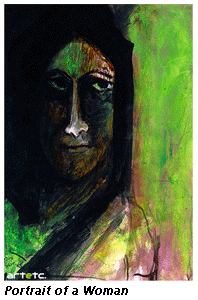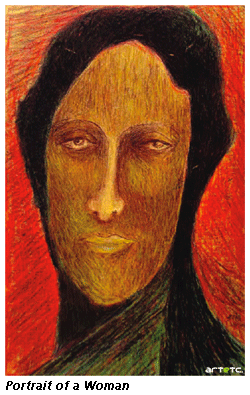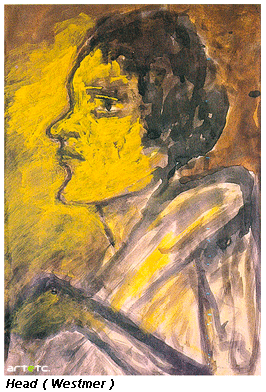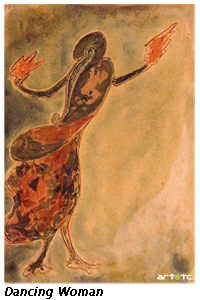- Publisher's Note
- Editorial
- Looking from the Other Side
- Women in Rabindranath Tagore's Paintings
- Ramkinkar Baij's Santhal Family
- The Birth of Freedom in Moments of Confinement
- Jamini Roy's Art in Retrospect
- The Great Journey of Shapes: Collages of Nandalal Bose
- Haripura Posters by Nandalal Bose: The Context and the Content
- The Post-1960s Scenario in the Art of Bengal
- Art Practice in and Around Kolkata
- Social Concern and Protest
- The Dangers of Deifications
- Gobardhan Ash: The Committed Artist of 1940-s
- Gopal Ghose
- Painting of Dharmanarayan Dasgupta: Social Critique through Fantasy and Satire
- Asit Mondal: Eloquence of Lines
- The Experiential and Aesthetic Works of Samindranath Majumdar
- Luke Jerram: Investigating the Acoustics of Architecture
- Miho Museum: A Structure Embedded in the Landscape
- Antique Victorian Silver
- Up to 78 Million American Dollars1 !
- Random Strokes
- Are We Looking At the Rise of Bengal
- Art Basel and the Questions it Threw Up
- What Happened and What's Forthcoming
- Art Events Kolkata, May – June 2012
- Mumbai Art Sighting
- Delhi Dias
- Art Bengaluru
- Preview June, 2012 – July, 2012
- In the News, June 2012
ART news & views
Women in Rabindranath Tagore's Paintings
Issue No: 30 Month: 7 Year: 2012
by Uma Prakash
Poet, artist, writer, playwright, composer and philosopher Rabindranath Tagore (1861-1941) painted different moods and forms of women. He was greatly influenced by the fascinating women who were part of his life. They were his sister- in- law Kadambari Devi (Srimati of his writings, committed suicide in 1884), his wife Mrinalini Devi (died of illness in 1902), and Victoria Ocampo (his companion in Argentina, Tagore's 'Vijaya' whom he met in 1924 and 1930). Tagore's artworks are more important about space, about childhood and love. It is only right that he should make our eyes and mind empathize with that which he has seen and felt.
Kadambari Devi was the nine years old child bride of Tagore's elder brother Jyotirindranath Tagore. She was nearly the same age as her young brother- in- law and was the poet's playmate and become his best friend, his mother, his strongest critique and his muse. He saw her first as a lost princess that needed protection, then as someone who mothered him and finally they were both teenagers developing a love for poetry.
Four months after Tagore's marriage to Mrinalini at the end of 1883 Kadambari Devi committed suicide. Though Kadambari Devi died very early, she continued to be the motivation for Tagore's writing for the rest of his life. The interplay between idea, poetry and painting is necessary to understand the artist's work. About 30 years after Kadambari's death Tagore composed the First Sorrow.
I was walking along a path overgrown with grass, when suddenly I heard from someone behind, "See if you know me?"
I turned round and looked at her and said, "I cannot remember your name."
She said, "I am that first great Sorrow whom you met when you were young (twenty-five)."
Her eyes looked like a morning whose dew is still in the air.
I stood silent for some time till I said, "Have you lost all the great burden of your tears?"
She smiled and said nothing. I felt that her tears had had time to learn the language of smiles.
I asked, "Still today you've kept with you that youth of mine when I was twenty-five?"
Said she, "Here, just look, my garland."
I could see, not a petal had fallen from the garland of that springtime back then.
I said, "Mine has become completely withered, but my youth at twenty- five is still this day as fresh as ever, hanging there about your neck.”
Slowly, she took off that garland, placing it around my neck. "Once you said," she whispered, "that you would cherish your grief for ever." I blushed and said, "Yes, but years have passed and I forget."
She added, "He who is the bridegroom of my inner thoughts, he had not forgotten. Since then, I've sat here secretly beneath the shadows. Accept me now."
Then I took her hand in mine and said, "But you have changed."
"What was sorrow once has now become peace," she said.


 Like this poem, First Sorrow, Kadambari seemed to be present in Tagore's paintings. He has felt her presence even in his Landscapes: the narrow path of the river shrouded with trees on either side leading to the golden horizon, lost in the lucid waters of the river, in the dark clouds of July, in the golden incarnations of September. Apparently, till his death Tagore felt the presence of Kadambari Devi's spirit around him which even prompted him to write a song - Timiro obo-gunthone, bodono tobodhaki, ke tumi ke tumi ke tumi momo ongone? This song corresponds closely to the painting of a heavily veiled (obogunthon) women surrounded by darkness (timiro). Timiro obogunthon – The veil of darkness is a very good description of the heavy dark veil seen in Portrait of a Woman, a familiar image from many Tagore paintings and is widely believed to be that of his sister-in-law, Kadambari Devi.
Like this poem, First Sorrow, Kadambari seemed to be present in Tagore's paintings. He has felt her presence even in his Landscapes: the narrow path of the river shrouded with trees on either side leading to the golden horizon, lost in the lucid waters of the river, in the dark clouds of July, in the golden incarnations of September. Apparently, till his death Tagore felt the presence of Kadambari Devi's spirit around him which even prompted him to write a song - Timiro obo-gunthone, bodono tobodhaki, ke tumi ke tumi ke tumi momo ongone? This song corresponds closely to the painting of a heavily veiled (obogunthon) women surrounded by darkness (timiro). Timiro obogunthon – The veil of darkness is a very good description of the heavy dark veil seen in Portrait of a Woman, a familiar image from many Tagore paintings and is widely believed to be that of his sister-in-law, Kadambari Devi.
Some of his paintings hauntingly bring out a strange sense of melancholia and death reflecting the loss of Kadambari that obsessed Tagore throughout his life. The sad faces, the shades of grey and black in most of his paintings and Tagore's references to Kadambari Devi as a subject of his paintings, give us an insight into the poet's creative subconscious. With dense crosshatching technique he created mysterious tonalities in many of his works. In Two Figures both the man and woman are lost in the whirlwind of sorrow trying to reach out to each other. Done in browns and subdued colours the painting evokes memories of his youth.
 It was speculated that it was Kadambari who probably fell in love with Tagore, while he was more in love with her memories after she committed suicide. Tagore's platonic relationship with his sister-in-law Kadambari (his only muse), comes alive in his novel Nastanirh (The Broken Nest) made into a film Charulata by the renowned filmmaker Satyajit Ray.
It was speculated that it was Kadambari who probably fell in love with Tagore, while he was more in love with her memories after she committed suicide. Tagore's platonic relationship with his sister-in-law Kadambari (his only muse), comes alive in his novel Nastanirh (The Broken Nest) made into a film Charulata by the renowned filmmaker Satyajit Ray.
To a young Amiya Chakravarty of about 16, who would a decade or so later become Tagore's literary secretary for a period of time, Tagore wrote in 1917, and he translated:
“Once, when I was about your age, I suffered a devastating sorrow, similar to yours now. A very close relative of mine committed suicide, and she had been my life's total support, right from childhood onward. And so with her unexpected death it was as if the earth itself receded from beneath my feet, as though the skies above me all went dark. My universe turned empty, my zest for life departed.”
On December 9th of 1883 at the age of 22 Tagore himself was married to a girl of 11, whom he renamed Mrinalini and with whom he had five children. Was Tagore's painting Mother and Child inspired by the birth of his first born, or is it the memory of his mother who passed away when he was very young? These are speculations and not conclusions to the love and life of the great poet.
 In 1924 soon after his arrival to Buenos Aires Tagore met a 34-year-old ravishing beauty, Victoria Ocampo. She had serious literary interests and had read Andre Gide's French translation of Gitanjali. Besides having a keen intellectual understanding of his (Tagore's) books, she was deeply attached to him. He named her Vijaya and dedicated the poems he wrote in Argentina to Victoria Ocampo under the title Purabi, His poems display his extraordinary control over the erotic and the sensual. On the faces of Untitled featuring a man and woman a languid sexuality pervades. The delicate nuances of the erotic, the mystical and the haunting visual appeal of the figures are to behold! It is evident that there is much more happening beyond the confines of the frame. The two met six years later in Paris where Victoria found a gallery to display Tagore's paintings. In an Untitled Head the painter portrays a western beauty which could have been Victoria.
In 1924 soon after his arrival to Buenos Aires Tagore met a 34-year-old ravishing beauty, Victoria Ocampo. She had serious literary interests and had read Andre Gide's French translation of Gitanjali. Besides having a keen intellectual understanding of his (Tagore's) books, she was deeply attached to him. He named her Vijaya and dedicated the poems he wrote in Argentina to Victoria Ocampo under the title Purabi, His poems display his extraordinary control over the erotic and the sensual. On the faces of Untitled featuring a man and woman a languid sexuality pervades. The delicate nuances of the erotic, the mystical and the haunting visual appeal of the figures are to behold! It is evident that there is much more happening beyond the confines of the frame. The two met six years later in Paris where Victoria found a gallery to display Tagore's paintings. In an Untitled Head the painter portrays a western beauty which could have been Victoria.
 Women from Tagore's novels seem to inevitably find their way into his paintings like the a Portrait of a Woman that evokes memories of the sad story of Bimala, a housewife tragically drawn to a fiery Indian nationalist, in his great novel Ghaire Baire (The Home and the World). Here Tagore's veiled woman raises her arm to her face, either about to rest her head or wipe away a tear. The emotion is further emphasized by her exposed breast, suggesting that she had just torn her clothes in mourning. Bimala's voyage into self discovery and experiment are intense in this painting. This work is painted in varieties of brown. With his understanding of line and awareness of minimal colour the artist emanates a naturalness that makes this work captivating.
Women from Tagore's novels seem to inevitably find their way into his paintings like the a Portrait of a Woman that evokes memories of the sad story of Bimala, a housewife tragically drawn to a fiery Indian nationalist, in his great novel Ghaire Baire (The Home and the World). Here Tagore's veiled woman raises her arm to her face, either about to rest her head or wipe away a tear. The emotion is further emphasized by her exposed breast, suggesting that she had just torn her clothes in mourning. Bimala's voyage into self discovery and experiment are intense in this painting. This work is painted in varieties of brown. With his understanding of line and awareness of minimal colour the artist emanates a naturalness that makes this work captivating.
 The fictitious character that Tagore created in his novels and poems seem to invade his canvas. It appears that the innocence and delicacy of Kamala from Noukadubi (Boat Wreck) is captured in Lady with Flower. Swirling with tonalities of black and grey the artist addresses the loneliness of Kamala. The emancipated Hemnalini is evident in the Head Study. Tagore brings sophistication to the expression of the girl. The focus is on her eyes. They are eloquent, they speak. Tagore uses crayons, ink and vegetable colours to create portraits that succeed in depictingthe smile in the eyes of a young girl or the sadness of a lonely woman.
The fictitious character that Tagore created in his novels and poems seem to invade his canvas. It appears that the innocence and delicacy of Kamala from Noukadubi (Boat Wreck) is captured in Lady with Flower. Swirling with tonalities of black and grey the artist addresses the loneliness of Kamala. The emancipated Hemnalini is evident in the Head Study. Tagore brings sophistication to the expression of the girl. The focus is on her eyes. They are eloquent, they speak. Tagore uses crayons, ink and vegetable colours to create portraits that succeed in depictingthe smile in the eyes of a young girl or the sadness of a lonely woman.
Tagore's Veiled Woman and his Tableau of Shrouded Women with their backs have a mysterious appeal: the private world of Indian women is peeped at but not revealed. Tagore reflects the attitudes towards women of his times although he himself was a part of reform movements that propagated social reform, education for women and widow's remarriage. In another Untitiled piece the light from the tiny window that enters the home of the woman summed up the limitations of the freedom of women of that era.
We move from real life to fiction in his paintings. The Untitled Lady with a Fan, is believed to be an image of Lady Ranu Mukherjee, the socialite and patron of arts in Calcutta. While one Head brings to life Rajan, the orphan girl from his novel The Post Master, another is a lady he created from the ideals about womanhood he cherished in his imagination - the Manipuri princess Chitrangada.
With no formal training, Tagore began painting at the age of 63. He referred to his art as 'Sesh boisher priya' - an affair in the sunset of life. Art (drawing and painting) took over from words to aid him in expressing his deep and unexplained feelings and emotions. Tagore breathes life into his images with the stroke of his brush often resonating characters that belong to his novels and poems. He used this medium to communicate during the later part of his life. In 1924 Tagore visited China and Japan with Nandalal Bose where he researched the brush and wash technique. The artist did not indulge in any preliminary or preparatory sketches, in fact his art often originated from corrections and deletions in the manuscripts he was writing, as he transformed them into his visual narratives.

A recipient of the Nobel Prize for Literature, Tagore was the founder of the Art wing at Kala Bhavana of Visva Bharati in Santiniketan (Abode of peace). His earlier works began as doodles executed while he wrote his poems and stories. His work later evolved into masterpieces and lyrical pieces of art. He himself confessed that the only thing he possessed from his young days was training in rhythm and sound. The inner rhythm of Tagore surfaces through his master strokes in the motions of Dancing Woman, allowing the protagonist the freedom to fly in the air. Through the light colours and flimsy clothes Tagore has created a woman who could be a modern-day dancer, contemplating, as she prepares to glide on the stage with the most incredible movement. His work was ahead of his time and through his abstract lines he portrayed the Figure in yellow and orange. These works places him in the league of today's contemporary painters. He shows how an artist who is playful with lines, even lyrically playful, can consciously move from figurative to pure abstract expressionism.